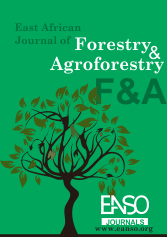Review of Plant Water Status Measurement Techniques
Abstract
The growth of the plant largely depends on the available water and soil. Soil supports the plant in mechanical ways and acts as a nutrient reservoir for its growth. Not only for plants but also for all living things, water plays a significant role in the life process. For a tree grower, knowing the relationship and techniques of measurement of plant, soil, and water help to improve their management system as well as the efficiency of crop production in a given area. Besides, it helps to know the relative water status of planted tree species. Therefore, this paper provides general information about seven plant water status measurements.
Downloads
References
Blum, A. (2011). Plant water relations, plant stress and plant production. In Plant breeding for water-limited environments (pp. 11-52). Springer, New York, NY.
Roberts, B. R. (1987). Methods for measuring water status and reducing transpirational water loss in trees. Journal of Arboriculture, 13(2), 57.
Knipling, E. B. (1967). Measurement of leaf water potential by the dye method. Ecology, 48(6), 1038-1041.
Ritchie, G. A., & Hinckley, T. M. (1975). The pressure chamber as an instrument for ecological research. In Advances in ecological research (Vol. 9, pp. 165-254). Academic Press
Xanthopoulos, G. (2004, April). Who should be responsible for forest fires? Lessons from the Greek experience. In Proceedings of the “II International Symposium on Fire Economics, Planning and Policy: a Global View”, April 19e22 (p. 189e202).
Menoux-Boyer, Y., Buriol, G., & Parcebaux, S. D. (1983). Use of two non-destructive methods for the measurement of plant water content: ecophysiological study of adaptative mechanisms in response to environmental stresses. In Photosynthesis and plant productivity: joint Meeting of OECD and Studienzentrum Weikersheim, Ettlingen Castle (Germany), October 11-14, 1981/editor: H. Metzner. Stuttgart: Wissenschaftliche Verlagsgesellschaft, 1983.
Parry, C. K. (2014). Biophysically-based measurement of plant water status using canopy temperature. Utah State University.
Scanlon, B. R., Andraski, B. J., & Bilskie, J. (2002). 3.2. 4 Miscellaneous methods for measuring matric or water potential. Methods of Soil Analysis: Part 4 Physical Methods, 5, 643-670.
Running, S. W. (1984). Microclimate control of forest productivity: analysis by computer simulation of annual photosynthesis/transpiration balance in different environments. Agricultural and Forest Meteorology, 32(3-4), 267-288.
Hinckley, T. M., Ceulemans, R., Cienciala, E., Kučera, J., Martin, T. A., Matyssek, R., & Nadezhdina, N. (2022). Jan Čermák’s lifetime contribution to tree water relations. Tree physiology, 42(8), 1517-1526.
Copyright (c) 2022 Melkamu Terefe Asmare

This work is licensed under a Creative Commons Attribution 4.0 International License.




























